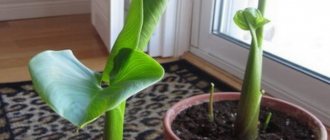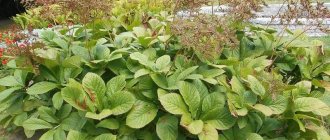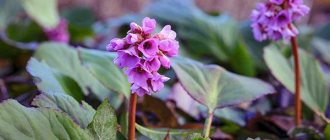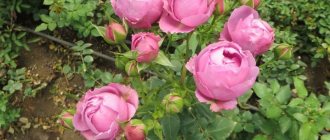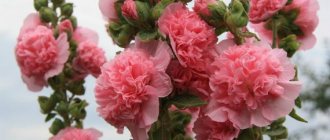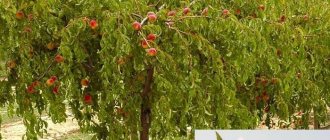The Chinese rose Angel Wings is designed to decorate local areas, greenhouses and even window sills of residential premises. Perennials bloom profusely and have a sophisticated appearance. Compared to other plants, they are distinguished by their grace and tenderness.
The rose has gained great popularity due to the fact that it is universal. It can be grown both in the garden and at home. Moreover, when kept indoors, it blooms continuously. The perennial is of great interest to lovers of plant design. It can be grown from seeds. This is a rather complex and at the same time fascinating process. From our article you will learn about the features of growing perennials and caring for them.
How to convert an outdoor plant to indoor use
If you were unable to grow a flowering perennial from seeds, but really want to see such a plant at home, then there is another way to admire a rose in a pot at home.
Care in this case will begin with ensuring a normal atmosphere so that the plant has a successful dormant period. First you need to take care of the temperature in the place where the bush with the earth ball will be located. Watering is stopped for this period, moistening is carried out very limited, only occasionally wetting the soil. The rose's winter dormancy period ends in March. At this time, it needs to be transplanted into a permanent flowerpot, trimmed and brought into the room. When the plant begins to grow, it will be necessary to resume abundant and regular watering.
Some gardeners prefer to propagate roses by cuttings. In the spring, parts of the shoots are cut off from young plants and placed in water. When they take root, they are planted in the soil outdoors. Thus, by growing roses in your garden plot, you can get flowers that bloom all summer long.
Angel wings are a type of Chinese rose.
The perennial variety is both a garden and potted plant.
And he feels great in Russian weather conditions.
Brief information about the plant
Initially, the perennial grew in China; by the 18th century it had already become known in Europe. Currently grown on a large scale in subtropical countries. Being a potted and garden plant, the rose feels great within our country and pleases its owners with numerous flowers. And this despite the fact that her usual environment is a tropical climate.
Lovers of indoor flowers classify the perennial as hibiscus. In fact, these are different types of plants. The confusion arose because hibiscus is commonly called Chinese rose. In fact, several species of perennials with this name have been bred. To be clear, professional flower growers explain that “Chinese rose” is simply the varietal name of hibiscus. We will consider the plant to which it rightfully belongs. The perennial has another name - “Angel Wings”. The Chinese rose has high adaptive abilities, so all flower lovers should learn about the secrets of its cultivation.
Rules for growing seedlings
We recommend that you read
Sowing of seeds is carried out in spring or autumn. If spring is chosen, then it is necessary to plant the schisanthus at the end of March, and the first flowers should be expected no earlier than July. But planting seeds in advance in September will allow you to see the first flowers in May.
How to sow seeds for seedlings:
- during planting, it is recommended to use light, permeable soil;
- do not forget about the need to add nutrients to the substrate;
- the depth of planting seeds should not exceed 3 cm;
- The optimal soil temperature for seedlings is 18 degrees.
Most often, seeds germinate at night, and this takes about three weeks. To maintain a good microclimate in the container with seedlings, it is recommended to cover it with black film. When warm weather arrives, it is recommended to place the boxes in places that receive a fairly large amount of heat in the apartment - on southern windows or a balcony.
The appearance of 2-3 leaves on the seedlings indicates the need to plant the seedlings. To plant the sprouts, you must use a wide knife or spatula. It is recommended to fill 200 ml cups, where 2-3 seedlings should be planted, with a similar substrate. After a month of germination in a glass, the young plants will need another transplant, carried out using the transshipment method, i.e., preserving the earthen clod. This allows you to protect young roots from damage. In this case, it is recommended to use soil suitable for adult plants.
It is very important to place pots with plants so that the schisanthus themselves do not touch each other
While the plants are still quite weak, an important role is given to their watering, which should be organized so as not to flood the soil or overdry it. Water should be enriched with complex fertilizers in small quantities, since plant growth requires good nutrition. If the plant will be grown in the fresh air, then two weeks before planting it in a flowerbed, it is necessary to gradually begin hardening it. The absence of frosts at night and good warming of the air during the day indicate that seedlings can be planted in open ground. It is recommended to maintain a distance of 25 cm between plants. The soil where schisanthus grows needs regular loosening and removal of weeds.
Sowing seeds in the fall allows you to enjoy the flowering of Angel Wings in May. During winter, crops can be kept in a cool place, but ensuring sufficient sunlight. Sluggish and weak plants should not be discarded; after planting in a flowerbed they will become stronger. Often these are the plants that end up being the most beautiful and blooming.
Bloom
When and how?
If you grow Angel Wings in a pot, the flowering continues without interruption . In open ground, this period lasts from April to July. During flowering, the bush is strewn with double and single flowers of pale pink and white-yellow.
Care
During flowering, fertilizing should be done once every 2-3 weeks. To do this, use complex mineral compositions in which nitrogen is present in minimal concentration. In addition, during the flowering period, hibiscus needs abundant watering. In spring and summer, do this 2 times a day - morning and evening.
After the buds have bloomed, they must be removed so as not to disturb the decorative appearance of the crop. At the end of flowering, the plant needs pruning (more information about when and how to prune a Chinese rose correctly can be found here). Watering can already be reduced, as can the addition of nutrients.
You can find out more about the features of caring for Chinese roses at home here.
Reasons for lack of flowering
There are many reasons why the Angel Wings variety does not bloom:
lack of light;
- irregular watering and application of nutrient mixture;
- poor quality soil.
To stimulate a flower, it needs to have a “winter” . The bottom line is to limit watering (once a week) during the winter months.
- Place the pot with the plant in a room where the temperature is 15 degrees Celsius. If these conditions are met, flower buds are laid in the required quantity.
- Also limit lighting by not placing the container in direct bright sun.
- At the end of February or at the beginning of March, water hibiscus frequently.
- Loosen the soil after moistening.
- Return the pot to its original place with good lighting and perform the first, and then all regular feedings.
The process of planting seed material
Agricultural techniques must be performed correctly, since we are dealing with a capricious plant. Here are the basic recommendations for planting seeds:
It is better to choose a container for planting that is transparent, plastic, and preferably with a lid. You can also cover pots with planted seeds with glass. The soil needs to be shed with Fitosporin solution. The container must have a hole to allow excess moisture to escape. Seeds should be spread out on the surface of the substrate in random order. Instead of soil, it is better to sprinkle them with “Vermiculite”. This will provide the seed material with more comfortable conditions for germination, and will also protect it from rotting. Then the container is placed in a warm place, for example, on a windowsill
It is important to ensure that there are no drafts and that the temperature is at room temperature. The lid should be opened periodically for ventilation. In total, shoots appear in a month
After the formation of 3 leaves, the plant needs to be pruned.
If you observe the correct temperature conditions, the seeds can sprout without stratification. If this does not happen within 14 days, then the pot with seed material is sent to the refrigerator for two weeks. Stratification in this case should be controlled. If shoots appear, they should be immediately moved to the windowsill.
When the young bushes grow up after the picking process, you need to choose a permanent place for them. Regardless of whether the perennial grows indoors or outdoors, the main thing is to provide it with light and warmth. When growing indoors, it is better to choose a windowsill on the south side and place the rose in a pot there. Caring for the plant at home is described in more detail below.
Ways to grow roses
Growing roses seems like a complicated process only at first glance. The main task is to choose a flower propagation method that will correspond to the variety and group of the plant.
Growing roses is not as complicated a process as it seems at first glance.
Roses are propagated in two main ways: vegetative and seed. Flowers that do not form seeds or do not transfer their properties and qualities when sown are propagated by the vegetative method. Vegetative propagation, in turn, occurs using the following methods:
- cuttings - propagation by cuttings from a bouquet, cut stems;
- dividing bushes by layering, suckers;
- grafting or budding.
Type of rose seeds
The seed method is used for growing rose species that produce full-fledged seeds, as well as when breeding a new variety or when cultivating rose hips for grafting as a rootstock. By “full seeds” we mean seeds that, when sown, produce a flower of the same quality as its predecessor.
Hybrids are not propagated by seeds. The offspring with this method grow up to be different from the parent. When non-hybrid varieties are propagated by seed, the descendants become similar to the original “wild varieties”. The seeds of miniature roses are more suitable for planting.
Few varieties can be propagated by seed. Among them are polyanthus, miniature roses, brown roses, needle roses, canina roses and others. One of the first roses offered for cultivation by seed in our country was the “angel wings” rose. Nowadays you can buy seeds of various varieties, but you can also grow flowers from seeds from your plot or from other rose gardens.
Return to contents
Prevention of various problems
When growing the Angel Wings variety, the following problems and ways to solve them are possible:
- Dropping leaves. If this process occurs in winter, then this indicates a low temperature in the room or the plant is in a draft. To solve this problem, you will have to find a warm place for the flower and reduce watering. If the leaves fall off in the summer, the reason is frequent waterlogging.
- The buds are falling. This occurs due to dry air. Every day, spray the plant with water at room temperature using a spray bottle.
- Spotting on leaves. The main reason is increased application of fertilizers or lack of light. To solve this problem, you need to temporarily stop adding nutrients and provide adequate lighting.
- Chlorosis occurs as a result of improper plant care. The leaves become deformed, curl, change shape, and the buds fall off without ever blooming. A lack of zinc, manganese, potassium and iron can affect the development of chlorosis. You can save the flower if you transplant it into new soil with the necessary fertilizers. Spray every day.
Angel Wings is a variety of Chinese rose that is valued by gardeners for its abundant and beautiful flowering, as well as resistance to diseases and pests. The plant rarely gets sick if it is cared for correctly and regularly. But you can grow it both at home and outside. Here everything depends on the choice of the grower.
If you find an error, please select a piece of text and press Ctrl+Enter.
>Angel Wings - Chinese rose Angel Wings: tips for care and growing from seeds
Advantages and disadvantages of the variety
The perennial Chinese rose Angel Wings is valued by gardeners for the virtues it displays. They are very important when choosing a variety for planting.
Delicate fragrant flowers are the main advantage of the variety
Pros of rose bush:
- abundant and long flowering;
- resistance to return frosts;
- high winter hardiness;
- cultivation in open beds and indoors;
- good immunity to diseases and pest attacks.
The variety has no pronounced deficiencies. If watering rules are violated, the rose may suffer from types of rot.
Post-procedure care
Hibiscus is an inhabitant of humid forests. To create comfortable conditions for it, you need to organize regular watering. The plant absorbs water and solutions from the soil especially actively during the period of active growth, that is, in summer. Some gardeners recommend watering seedlings daily, the main thing is to avoid stagnation of water.
To ensure intensive growth and development of hibiscus, fertilizers must be added to the soil. They are especially important during the flowering and fruiting period. At this stage, garden potassium is added to the soil. Before flowering and during the “rest” between flowering, hibiscus can be fed with nitrogen. Despite the fact that this element is necessary for the formation of green plant organs (leaves, buds and new shoots), an overdose of nitrogen can cause burns on the leaves.
During the winter dormancy period, it is better to stop fertilizing completely. The hibiscus will need to be pruned periodically. This procedure is especially important after winter dormancy. It will awaken dormant buds and thus rejuvenate the plant.
Schizanthus care
The flower requires considerable attention and the fulfillment of certain conditions for caring for itself.
Watering
It is necessary to carefully consider watering the plant due to the fact that the flower does not like either waterlogging or drying out. It should be carried out according to the degree of drying of the earth's surface, the stream of water should be directed carefully under the root, without getting on the leaves and flowers. The water should be warm.
Settled rainwater heated naturally in the sun is ideal.
Fertilizers
Schizanthus is very grateful for systematic feeding. For these purposes, mineral fertilizer complexes are used, and phosphorus fertilizers are used before flowering. From planting until the first flowering, fertilize every month, then every week, but reducing the concentration of fertilizing by half. Subsequently, this will ensure rich, beautiful and bright flowering.
When using the plant as an indoor plant, garden soil is added to the pot, into which peat and sand are also added. It is very important to ensure drainage. Water homemade schisanthus with water and complex fertilizers. Next, the same care is required as for other indoor plants.
Characteristics and features of the variety
Angel's wings can easily be called a capricious and changeable perennial when it comes to growing it. An adult plant is less demanding in terms of living conditions. The biggest difficulty in this floriculture process is that the bush needs to be grown from a small seed. If you make a minor mistake when germinating planting material, sprouts may not appear. And if you do not properly care for already overgrown young plants, they may die.
Chinese rose seeds are also not particularly encouraging with their potential. Usually, out of 10–12 units in a store package, only 2 sprouts sprout. Based on the observations of flower growers, we can say that the germination rate of imported seeds is somewhat better than that of ordinary seeds, but also not much. Despite all this, the chances for amateur flower growers are still great. After all, if you wish, you can fulfill all the necessary requirements and get a beautiful outdoor or indoor flower.
A small lush bush with many branches strewn with delicate inflorescences of light shades, it has long become one of the most popular Chinese hibiscus scrubs among gardeners. Grows 20 cm tall with thin but strong green stems. There are a lot of branches on the bush, which gives it splendor and elegance. The leaves are bright green, small in size, jagged along the edges.
Angelic polyanthus rose blooms long and profusely. One rose bush can have up to one hundred inflorescences. The buds for a plant are half a meter long, large, from 4 to 9 cm. The petals of each subspecies are different. They can be terry, semi-double or flat. The color of the flowers is white and pale pink. Sometimes one bush can combine flowers of both colors. They are connected into inflorescences.
Chinese rose Angel Wings, grown in the garden, blooms from early April to late July, in a pot - all year round without interruption. It can be grown by seeds and cuttings. The seeds of the crop take a very long time to germinate, so its propagation requires patience. After they have sprouted, already in the third month the first flowers appear. Rose Angel Wings differs from other Chinese roses in its higher winter hardiness. This is especially noticeable on bushes grown from seeds.
In order for the sprouts to hatch through the shell, they must be stratified. To do this you need:
- Disinfect seeds. Dip in hydrogen peroxide. Keep for 20 minutes. Remove the floating seeds, as they are empty and unsuitable for planting.
- Take out the seeds, place them on a slightly moistened non-woven material, and cover with it on top. You can also use cotton pads. Wrap in a plastic bag and place in the bottom of the refrigerator for 60 days. After this time, the first shoots should form.
- Seeds need to be constantly checked and, if necessary, moistened. For prevention, you can re-treat with peroxide.
- Plant the seeds that have sprouted in a pot. The planting container should not be too deep. Small holes need to be made in the bottom to prevent water accumulation.
- Pour drainage (fine gravel or crushed stone) onto the bottom of the pot, and pour the prepared soil onto it.
- Place the seeds on the ground and sprinkle with river sand or vermiculite.
- Cover the container with a transparent lid, glass or cover with film.
- Place the pot with planting material on a windowsill where there are no drafts, or in another well-lit place.
When growing Angel Wings roses from 10-12 seeds, only 3-5 can grow.
As it grows, it is necessary to transplant it into a pot with a larger diameter. Adult plants are replanted less frequently - once every few years. For safe transplantation, the earthen ball must be completely entwined with the roots of the plant. After transplanting, for the first time, it is better to water the plant from a tray. This way the roots will cling to the new soil.
Types and varieties of schisanthus
The culture has about 12 different varieties. The table shows the most popular of them.
| View | Description | Flowers / Height | Varieties |
| Graham | Cultivated since 1831. There is a wide palette of flower colors. Branched bush, annual. Grows in the Andes, Chile. Height is about 50-60 cm. The petals of the inflorescences can be spotted, striped or interspersed. | Purple. | Var. lilacinus. |
| Lilac. | Var. aibus. | ||
| White, scarlet. | Var. carmineus. | ||
| Pinnate | Released in 1822. Annual. Large selection of varieties and shapes of flowers. Originally from South America. Grows in length from 45 cm. | Small petals, striped, lilac, white, scarlet. The inflorescences are collected from small fluffy racemose flowers. Flowering May – September. | Picollo. |
| Visetonian | Exists since 1900. A popular hybrid, crossed from the two previous species, an annual. It has colorful, interestingly shaped, large flowers. | Scarlet. Reaches 40 cm. | Diamond. |
| Large, carmine color. Approximately 30-40 cm high. | Rother Herold. | ||
| Scarlet, carmine. Dwarf, no more than 25 cm tall. | ZwergBuckett. | ||
| White, interestingly shaped petals, visually reminiscent of angel wings. About 40 cm tall. | Angel wings. | ||
| Flowers up to 2 cm in diameter. Red, single, cream color. Height up to 40 cm. | Monarch. | ||
| Striped or spotted. Pink, raspberry, lilac. Tubular shape. Does not exceed 20 cm. | Fiji. | ||
| Flowering – July-September. Petals are cream, pink, crimson. Reaches 55 cm. | Hybrid mixture. |
Diseases and pests
| oroze.ru » src=»https://qlumba.com/wp-content/uploads/2019/06/fmg5cf8ab3e5f5a57.jpg» alt=»table_pic_» w /> | 1. Rust. |
Ways to fight:
- trim and destroy diseased parts of the plant;
- replace the top layer of soil with fresh soil in open ground or transplant the plant into another pot with fresh soil mixture;
- spray the rose with a solution of soap with the addition of infusion of horsetail or nettle;
- in case of significant damage, treat the plant with fungicides Hom, Falcon, Bayleton
rozisad.ru » src=»https://qlumba.com/wp-content/uploads/2019/06/fmg5cf8ab3e9dde83.jpg» alt=»table_pic_» w />
2. Powdery mildew.
Ways to fight:
- remove all affected parts of the plant and burn;
- spray the bush with a soda solution (to do this, dilute 5 grams of soda in 1 liter of water);
- treat the plant with Topsin-M or other fungicides
rozisad.ru » src=»https://qlumba.com/wp-content/uploads/2019/06/fmg5cf8ab3f0c1954.jpg» alt=»table_pic_» w />
3. Bacterial cancer
Ways to fight:
- dig up the bush or remove it from the pot;
- cut off all affected parts of the roots and burn;
- after pruning, treat the root system with a 1% solution of copper sulfate;
- transplant the bush to a new place on the site or into another pot with fresh soil mixture
cvetok-v-dome.ru » src=»https://qlumba.com/wp-content/uploads/2019/06/fmg5cf8ab3fd0c021.jpg» alt=»table_pic_» w />
4.Spider mite
Ways to fight:
- do not allow the soil and air to dry out to avoid the appearance of ticks;
- in dry weather, spray the leaves with water;
- cut off parts of the plant affected by mites and burn them;
- treat the plant with Vermitec or Actofit
stylishgarden.ru » src=»https://qlumba.com/wp-content/uploads/2019/06/fmg5cf8ab404cdad3.jpg» alt=»table_pic_» w />
5.Green rose aphid
Ways to fight:
- regularly inspect the rose to detect the pest in time;
- if a small number of aphids appear, wash the rose with a soap solution with the addition of mustard powder;
- if there are a large number of aphids, use the preparations Aclectic, Karbofos or Rogor
Seed method of growing roses
Seeds are selected at the end of July or August. The fruits at this time have a beautiful red or yellow color. It is necessary to select fruits with a slight blush. Seeds from unripe fruits usually germinate better than from ripe ones.
Carefully cut the skin of the fruit and divide it into two halves. We carefully remove the seeds, separating them from the pulp. Seeds, both purchased and from your own plot, can be of different shapes. This shouldn't bother you. The shape of the seed will only affect the originality of the grown flower. Before sowing, the seed is sometimes soaked in growth stimulants (heteroauxin, root). This procedure activates the growth process and accelerates the emergence of the first shoots.
Return to contents
Seed stratification
Before you start growing a seed, it must go through a stratification procedure. Stratification is one of the methods of pre-sowing seed preparation. This term means interlayering. The seed is layered with a moist substrate and stored at a certain temperature. Under natural conditions, seeds germinate only after lying in the ground under a layer of snow during the winter. Thanks to the snow cover, the seed receives the optimal temperature and necessary moisture. The same regime should be created artificially when growing certain types of roses.
To do this, you will need a piece of cloth, a paper towel or cotton pads. Soak the prepared material with peroxide, place the seeds on top of it and cover with a moistened piece of cloth or a cotton pad. Coffee filters are also used; the beaks are clearly visible against their dark background. The density of the filters does not allow sprouts to grow into the material.
Napkins with seeds are placed in plastic bags so that the peroxide does not evaporate. Each bag bears an inscription with the name of the variety of the mother flower and the date of planting for stratification. The packages are placed in the vegetable sector of the refrigerator, where the temperature should be maintained within +4 - +5°C.
Periodically, the seed must be checked for mold. When it appears, the material is replaced with a new one, also processed. With normal development of the process, sprouts should appear in one and a half to two months.
Return to contents
Sowing seeds
Seeds that germinate earlier than expected are sown immediately. To sow seeds, use separate pots or peat tablets. When growing roses, the disease “black leg” sometimes appears. To protect against this disease, the surface must be mulched with a 1 cm layer of perlite. Constant monitoring of soil moisture is necessary.
Shoots appear on the 3-7th day. In some seedlings the “cap” of the shell does not fall off. It is recommended to drop drops of water onto the shell to facilitate the process. From the moment of germination, sprouts need 10 hours of daylight for their normal development. Therefore, you cannot do without additional lighting equipment.
The bud should appear after about two months. And in 3-5 weeks the first flowers will bloom. You need to continue monitoring the plants. Water the seedlings regularly and apply soluble fertilizers in strict doses.
One of the types of Chinese rose Angel Wings has the Latin name Angel wings. Currently it is cultivated all over the world.
It is widespread in the subtropics and tropics because this climate is the most suitable for this plant. The history of the Wings of Angels rose began several thousand years ago in southern China, and in the 18th century it was brought to Europe.
Flowers of the Chinese rose Angel Wings, collected in inflorescences.
There can be up to 100 of them on a bush. They are mostly pink or white. The petals are smooth and terry. As the plant grows in size, the petals become larger. At the end of growth, an elastic bud is formed.
Ground requirements
The substrate can be purchased at the store or prepared yourself. Flower growers recommend buying special soil from the “Garden of Miracles” series for the Chinese rose Angel Wings. To prepare the substrate with your own hands, you need to take peat, sand and turf soil in equal proportions, or add a little sand and a peat tablet to the universal flower mixture. The latter must first be soaked in water.
Rose “Angel Wings” is not demanding on soil - you can buy it at a gardening store. It would be good if it was specifically designed for hibiscus. The most important thing is that the soil should be airy and sufficiently (but moderately) moisture-absorbing.
If there is no special soil on sale, you can prepare it yourself: to do this, add a little sand and humus to a regular peat substrate. At the bottom of the container for seedlings (and even for adult plants), you should definitely put some drainage material (for example, expanded clay).
Potassium permanganate solution
The container for growing from seeds should be shallow. Plastic food containers, such as cookies, work well. Having placed a little drainage material at the bottom, the prepared soil is poured on top.
Transparent plastic box
Seeds of the Angel Wings variety need stratification. This procedure will speed up germination and increase the overall chances of sprouts appearing. Stratification is a way of simulating natural conditions under which natural mechanisms are triggered in the seeds, causing the sprouts to hatch through the shell.
| Steps, photo | Description of actions |
| First, the seeds are disinfected. Seeds of the “Angel Wings” variety are placed in a small sieve, lowered into a container with hydrogen peroxide poured into it for 20 minutes. The liquid around the seeds will bubble - this is normal. Also during this procedure you can find out which seeds will never sprout. Empty seeds will float to the surface - they are removed and not planted in the ground. | |
| After disinfection, the seeds are removed from hydrogen peroxide and placed on cotton pads moistened with the same solution. The planting material laid out on top is also covered with a piece of damp cotton pad. | |
| “Packages” of cotton pads with rose seeds hidden inside are placed in small plastic bags. It is convenient to use zip-lock bags for these purposes. With their help, it will be possible to maintain the necessary humidity for a long time. On each bag, be sure to write the date of planting the seeds and put them in the refrigerator in a vegetable drawer (air temperature 5-7 degrees). |
Periodically look into the bags and see how the seeds feel. If mold appears, they are dipped again in the peroxide solution, packed in new cotton pads and put back in the refrigerator. The first shoots may appear in about 1.5-2 months.
Stratification can be carried out in a slightly different way, combining this process with planting. To do this, the seeds are treated with growth stimulants (for up to 8 hours), and then they are immediately sown in the prepared soil, sprinkled with sand on top.
After this, the crops are moistened with water, covered with glass or a plastic bag and left in the room. After a couple of weeks, the container with the future seedlings is placed in the refrigerator on the bottom shelf and kept there for about a month.
Very often, the first shoots (provided that the planting material was of high quality) appear already during this period. During stratification in this way, the condition of the crops and soil moisture are monitored, and if necessary, the soil is moistened.
As soon as the first shoots appear, the container is placed in a bright, but not brightly lit place with a temperature of up to 18 degrees. By the way, if the sprouts did not appear during the stratification period, the container with the seedlings is still removed from the refrigerator and placed in the conditions described above.
Mini-greenhouse made from a plastic container
Care
Let's take a closer look at the stages of planting and caring for the Chinese rose Angel Wings.
Landing
Angel wings cannot be called very unpretentious plants; if not properly cared for, they die very quickly. This variety is sprouted from seeds. There are usually a little more than ten of them in a package.
Growing Chinese rose Angel Wings from seeds is not easy. The seeds must be placed in a special substrate (sold in stores) to a depth of 5 mm, sprinkled with soil on top, slightly moistening it, and covered with glass. Glass can be removed occasionally to moisten the soil and saturate it with oxygen.
You can make the soil yourself. Pour drainage (for example, crushed polystyrene foam) into the bottom of the pot, pour in a universal flower mixture, add sand, and add a peat tablet on top, after soaking it in hot water.
To be more confident, before planting the seeds, they can be soaked in water or a weak solution of potassium permanganate for 2 weeks. The first shoots should appear within 30 days.
A video on the topic “Chinese rose Angel Wings, growing from seeds” will help you understand the intricacies of the issue:
Priming
The soil must be air and waterproof
Important. You can purchase regular peat soil or a flower mixture, add humus, sand and drainage.
Watering
During the period of growth and flowering, the flower must be watered abundantly (both if the flower is in the open ground and if the flower is in a pot at home).
If the plant is in a pot, then you need to pour water into the pan; only a little water can be poured under the roots of the flower to moisten the top layer of soil.
Stagnation of water also has a bad effect on the flower, so it is better to pour out the remaining water from the pan. The top layer of soil should always be moist.
The leaves need to be sprayed. After flowering stops, when the leaves begin to fall off, watering should be stopped, only occasionally moistening the earthen ball.
Lighting, temperature
All roses love light and warmth. If the house has windows facing south, then it is better to place Angel Wings there. The same applies to open ground situations. For long and persistent flowering, flowers need 4-6 hours a day in the sun.
The ideal temperature is from +24 to +30. If the temperature drops below +10, the plant will die. However, if the temperature is very high and the sun's rays are direct, then it is necessary to protect the roots of the rose from overheating. It is better to do this immediately upon planting, sprinkling the roots with an extra 2-3 cm of soil on top.
Feeding
Rose "Angelwings" definitely needs to be fed. Any universal remedy for potted plants will do This type of plant also needs magnesium. It is better to take magnesium in chelated form. You need to feed the flower in the morning, in cool weather, once a week. It is possible more often, but then the dose should be significantly reduced.
Pests, diseases
Important. If the care is completely correct, then pests and diseases will not bother the rosette.
Millimeter-sized insects that cover plant leaves with barely noticeable cobwebs. The leaves turn yellow, fall off and wither. Because of it, the plant can be affected by gray rot. As a preventive measure, the plant must be sprayed regularly, but do not allow water to stagnate in the rose buds.
It is necessary to remove fallen leaves and dried buds. If the disease still overtakes the rose, then it needs to be sprayed even more often. You can water the plant thoroughly and cover it with a plastic bag for three days. High humidity should kill the ticks.
You can also irradiate the underside of the leaves with ultraviolet light. But in this case, it is better to prevent the appearance of the pest, since fighting it greatly exhausts the rose and its owner.
One aphid does not pose a threat, but if there are many of them, the plant is in real danger. The leaves of a diseased plant will turn yellow, curl into tubes and fall off. The flower will become sluggish and will not bloom, but if there are a lot of pests, the leaves will become sticky from aphid secretions.
It is easier to prevent aphids from appearing than to fight them later. But it is quite possible to win. If several aphids have settled on the plant, you can try washing the leaves with very cold water or wiping them with soapy water.
If the aphids have already taken over the plant as a habitat, then you will have to use special chemicals that can be purchased in the store. After defeating the aphids, the Angel Wings will take some time to recover, and they need especially careful care during this time.
Leaf chlorosis
An unpleasant disease caused by violation of the conditions of its detention. Appears due to improper care.
The leaves begin to change shape, curl, spots of dirty flowers appear on them, rose buds fall off without blooming.
Chlorosis is a disease in which the plant lacks Zinc, Iron, Manganese, Potassium and other substances.
To save the flower, it is worth replanting it in a new substrate with the necessary fertilizers, carefully and daily spraying the leaves.
If the disease has just begun, then you can do without replanting by adding useful substances to the soil.
Absolutely all Angelwings diseases arise due to improper care, so if all the rules are followed, the plant must be absolutely healthy. If any signs of disease appear, then you need to immediately correct errors in keeping this flower. This can nip the disease in the bud.
Why is the rose “Angel Wings” on our website in the hibiscus section?
It's simple - many flower growers are still confident that this plant belongs to this species. However, this is a misconception. The confusion in the names was due to the fault of traders.
The thing is that in recent years, Chinese breeders have bred several similar varieties of roses. They began to be called Chinese roses. And before that they called Hibiscus. Hibiscus Chinese rose is the specific name (Hibiscus rosa-sinensis) of a specific species that has long been grown indoors.
Rose "Angelwings" is an excellent choice for the garden and home. It will delight the owner's eye and look truly beautiful. And caring for it is simple and pleasant.
If you find an error, please select a piece of text and press Ctrl+Enter.
Types of schisanthus
The most common among cultivated species of schisanthus are two species.
- Graham's schisanthus is a herbaceous plant reaching a height of 60cm. The stems are rigid, highly branched, slightly pubescent. The flowers are small, bright pink with a long lower and short upper lip. The flowers have many yellow spots with purple streaks. Many varieties of this species have been bred with white, carmine and purple flowers.
- Schizanthus pinnata is a pubescent plant reaching a height of 45 cm. The stems are branched. The flowers are purple, collected in racemes at the top. The lower lip of the flower is divided into three parts. There are purple spots at the base.
- A hybrid was obtained from these two species - Schizanthus Visetonian. It can be argued that this is the most beautiful hybrid of all. It reaches a height of 80cm. The flowers are very diverse and unusual in color. There are varieties of this hybrid with scarlet-carmine, brilliant-carmine flowers and the most diverse and bizarre.
How to get rid of pests?
If you bring new plants into your home, they should be carefully inspected for pests. All sorts of harmful insects - whiteflies and scale insects - can move from them to the Chinese rose. They will bring you a lot of trouble, and you will also need to learn how to get rid of the fly. In a flower pot, tropical perennials are usually attacked by aphids and spider mites. The second one needs to be seriously fought, because it causes the plant to become sick with gray rot. The main preventive measure against the pest is regular spraying. This should be done in such a way that water does not accumulate in the buds.
Aphids are destroyed by washing the foliage with cold water and by treating with a soap solution. If conventional methods do not help, then you need to purchase special chemicals against pests.
With these roses, it is important to remember that it is best to prevent them from becoming diseased, as perennials take too long to recover. On the other hand, with proper care, plants rarely get sick.
Schizanthus flowering
The plant blooms very profusely. Schizanthus is planted in hanging pots, garden vases, and used to create flower arrangements in flower beds, flower beds and mixborders.
Most representatives of the crop are pollinated by bees. Butterflies participate in the pollination process of several varieties.
The inflorescences of the culture can cause allergic reactions.
A flowering plant can cause an allergic reaction. There were isolated cases of individual intolerance.
How to propagate?
IMPORTANT: The Angel Wings variety is propagated by cuttings and seeds. The second method of propagation is preferable, since it is simpler and takes little time. The process of planting seeds was discussed earlier, so it is worthwhile to dwell in more detail on cuttings:
The process of planting seeds was discussed earlier, so it’s worth looking at cuttings in more detail:
- In spring, take cuttings from young shoots of the plant. Just choose ones that are not too stiff.
- Place the material in water and wait for roots to form.
- After this, send the cuttings into the ground.
You can find out more about how to propagate Chinese roses at home here.
Reproduction methods
Seedlings of the Angel Wings variety are propagated in two ways:
- Seeds. This is the main method preferred by gardeners. It allows you to get new plants with good characteristics. Seed germination is average and requires patience. But if you follow the recommendations for caring for seedlings, problems with reproduction will not arise.
- By cuttings. This option is used much less frequently. For cuttings in the spring, blanks should be cut from non-lignified young shoots. Then they need to be placed in a container of water. When roots appear, transplant the seedling into the ground. Such plants are more sensitive to environmental conditions.
Important! If a rose is taken from cuttings, the winter hardiness of an adult bush will be significantly lower. Therefore, growing from seeds is considered a priority for the Chinese beauty Angel Wings.
The seeds of the crop germinate poorly; the gardener will need patience
Pests, diseases
Important. If the care is completely correct, then pests and diseases will not bother the rosette.
Spider mite
Millimeter-sized insects that cover plant leaves with barely noticeable cobwebs. The leaves turn yellow, fall off and wither. Because of it, the plant can be affected by gray rot. As a preventive measure, the plant must be sprayed regularly, but do not allow water to stagnate in the rose buds.
It is necessary to remove fallen leaves and dried buds. If the disease still overtakes the rose, then it needs to be sprayed even more often. You can water the plant thoroughly and cover it with a plastic bag for three days. High humidity should kill the ticks.
You can also irradiate the underside of the leaves with ultraviolet light. But in this case, it is better to prevent the appearance of the pest, since fighting it greatly exhausts the rose and its owner.
Aphid
One aphid does not pose a threat, but if there are many of them, the plant is in real danger. The leaves of a diseased plant will turn yellow, curl into tubes and fall off. The flower will become sluggish and will not bloom, but if there are a lot of pests, the leaves will become sticky from aphid secretions.
It is easier to prevent aphids from appearing than to fight them later. But it is quite possible to win. If several aphids have settled on the plant, you can try washing the leaves with very cold water or wiping them with soapy water.
If the aphids have already taken over the plant as a habitat, then you will have to use special chemicals that can be purchased in the store. After defeating the aphids, the Angel Wings will take some time to recover, and they need especially careful care during this time.
Leaf chlorosis
An unpleasant disease caused by violation of the conditions of its detention. Appears due to improper care.
The leaves begin to change shape, curl, spots of dirty flowers appear on them, rose buds fall off without blooming.
Chlorosis is a disease in which the plant lacks Zinc, Iron, Manganese, Potassium and other substances.
To save the flower, it is worth replanting it in a new substrate with the necessary fertilizers, carefully and daily spraying the leaves.
If the disease has just begun, then you can do without replanting by adding useful substances to the soil.
Absolutely all Angelwings diseases arise due to improper care, so if all the rules are followed, the plant must be absolutely healthy. If any signs of disease appear, then you need to immediately correct errors in keeping this flower. This can nip the disease in the bud.
Pests and diseases
When the basic agrotechnical requirements are met, the Angel Wings rose demonstrates excellent immunity to diseases and pests. If there are failures in care, the plant may be attacked by spider mites. To prevent its occurrence will help:
- regular irrigation of the bush, but without stagnation of water in the buds;
- timely removal of faded buds;
- removing dried leaves from a bush.
The most effective actions against spider mites are preventative
Another dangerous pest is aphids. Bree large colonies of the rose insect may die. Insecticides must be used.
At the same time as aphids, ants should be controlled in the area.
Among the diseases, leaf chlorosis is most often found on Angel Wings. It appears when the rules for caring for a rose are violated.
It is important to monitor the presence of microelements in the soil to prevent chlorosis
Transplanting into new nutrient soil and regular sprinkling will help.
Reproduction
All gardeners unanimously say that this species is best propagated by cuttings; propagation by seeds gives practically no results. For cuttings, it is better to choose the healthiest bushes.
Bloom
In a pot, "Angelwings" can bloom almost continuously. In open ground, the flowering period is from late April to mid-July.
Transfer
Hibiscus grows very quickly, so you will need to stock up on a large number of pots.
Young plants several times a year. As it grows, it is necessary to transplant it into a pot with a larger diameter. Adult plants are replanted less frequently - once every few years.
For safe transplantation, the earthen ball must be completely entwined with the roots of the plant.
After transplanting, for the first time, it is better to water the plant from a tray. This way the roots will cling to the new soil.
Briefly about transplantation
At the first stage of their development, perennials grow quite quickly. So the transplant will have to be done several times a year. Therefore, if you decide to grow roses at home, you need to immediately stock up on flowerpots that will be larger in their parameters than the previous ones.
Moving to a new place for the plant will be safe only if the earthen ball is completely enveloped in the root shoots of the crop. After transplantation, moistening is carried out from the tray so that the roots take root well in the new substrate.
Botanical description
The rose bush grows up to 20, sometimes up to 30 cm. Its shoots are thin and quite strong. The leaves, serrated along the contour, are medium-sized, neat, and have a pronounced green color. A distinctive feature of a rose is that its buds are always collected in inflorescences, which en masse cover the bush. Color shades range from white to pink. The buds are dense, the petals can be either double or simple. It also happens that flowers of different types are formed on one bush. Professionals associate this nuance with seed material from different manufacturers. Imported flowers most often grow double flowers. The bush produces many shoots, making the plant look elegant and lush.
Description
| Rose Angel Wings (lat. Angel Wings) | |
| general characteristics | Straight-growing compact thorned hybrid tea bush |
| Plant height | up to 60 cm |
| Flower size | up to 3 cm |
| Color | White |
| Bloom | From late May to mid October |
| Winter hardiness | Frost-resistant variety (up to -25ºС) |
- The name is rose Angel Wings (lat. Angel Wings).
- Shape : Upright miniature bush.
- Height – 40 – 60 cm.
- Crown diameter – 60 cm;
- Flowers - double, semi-double, simple, pink, soft pink, white - yellow, up to 3 cm in diameter, collected in inflorescences of 5 - 10 pieces, fragrant. Often flowers of varying degrees of fullness and varying intensities of color open on the same plant.
- Flowering - from April to frost in open ground. If a rose is grown as a potted crop, then with proper care, flowering is almost continuous.
- The leaves are small, bright green, numerous.
- Rose loves well-lit areas without drafts.
- The variety needs fertile substrates , loose, well permeable to water and air.
- Rose Angel Wings is very thermophilic . The optimal temperature for growing is from +24 to +30 degrees. Therefore, roses are mainly cultivated as a potted plant. However, with good cover with spruce branches and snow, the rose will successfully overwinter in open ground.
- Reproduction - cuttings and growing from seeds. Rose seeds do not require mandatory stratification.
Varieties of Chinese perennial garden rose
The vibrant appearance of hibiscus makes it a favorite in home gardens. The most popular varieties of perennial Chinese rose:
- Alicante – red;
- Rosa – pink;
- Flamingo – red with pink;
- Koenig - yellow.
The Chinese garden rose “Angel Wings” is in great demand.
This is a bush whose height is 25–65 cm. The foliage is bright green. The thin, durable stem of this plant also has a green color. “Angel Wings” is notable for its abundant inflorescence of white or soft pink shade. The petal can be smooth, semi-double, or double. It is advisable to grow this variety by seed.
Detailed description
ATTENTION : Angel Wings is a bush, 20 cm high. It has small and neat leaves of bright green color. The stem, although thin, is strong. His color is also green.
There can be quite a lot of leaves, and they also differ in size. On one bush it can form up to 100 inflorescences. The most common flowers are white and pink, as well as all their shades . The petals are terry and smooth. As the flower grows, the number of petals increases, and at the end of growth an elastic bud is formed.
Growing from seeds
It is not difficult to grow a plant with or without seedlings in open ground; to do this, you need to familiarize yourself with the basic principles.
Sowing seedlings
You can speed up flowering if you first grow seedlings from seeds. The most suitable time of year is autumn, since the first flowering can be observed closer to summer.
To achieve maximum continuous flowering, it is best to sow once a month, from September to April.
Scatter over loose soil, sprinkle a couple of millimeters of sand on top and cover with plastic film or transparent glass to create a greenhouse effect. It is recommended to store the container in a dark place, observing the temperature range of +15...+23 °C. The sowing ripens in about three weeks; according to the observations of gardeners, the first shoots appear at night. When the first leaves appear, the seedlings are planted in different containers, including up to 3 pieces per pot. When the shoots reach a height of 8 cm, and then 16 cm, it is necessary to pinch them.
Before planting in open ground, the seedlings should be allowed to get used to sunlight. There is no need to rush to get rid of weakened seedlings, as they can subsequently bloom very impressively and densely.
Site selection and soil preparation
Schizanthus should be planted in a well-lit place. In arid environments - partial shade. With a lack of sunlight, the flowers bloom poorly, the plant loses its spectacular decorative appearance and stretches out. The crop is demanding on the soil: it must be sufficiently moist and rich in nutrients. To do this, the soil is pre-fertilized with compost, humus or rotted manure. Be sure to use drainage.
Sowing in open ground
Sowing is carried out at the end of April or beginning of May, when the air at night is already warm enough. The soil must be acidified and drained. Sand or peat is added to the ground. Many gardeners plant a flower in pots so that during dry weather or heavy rainfall they can place it in a more protected place - for example, on a terrace or balcony.
Pinnate
Planting seedlings in open ground
Seating is necessary only after the onset of warm weather, when frost is excluded. You should prepare holes with a small layer of humus. Plant the seedlings together with a lump of earth in a designated hole. Bury the sprouts to a depth of approximately 10 cm
When digging holes, you should maintain the distance between them, paying attention to the height of the bush: low - approximately 25 cm, medium - 40 cm, tall - at least 70 cm. If necessary, use support for tall plants
It is advisable to plant them several days apart to observe development.
Schizanthus pruning
After flowering, it is necessary to remove faded inflorescences. The emerging seed pods prevent further formation of buds. Sparse or too short flowering can be stimulated by pruning. To do this, you should cut off a third of all shoots. In a few days, new bud formation will begin.
The plant easily withstands sanitary and stimulating cleaning. By shortening the stems and shoots, you can maintain the rate of development of schisanthus.
The culture can also be used for cutting and creating flower arrangements. Schizanthus bouquets are distinguished by their ability to maintain freshness for a long time.
Latest articles about gardening
How to grow early cabbage seedlings so that they do not stretch?
How to grow tomato seedlings in a greenhouse?
How to grow pepper seedlings?
Features of growing Chinese roses
Angel's wings can easily be called a capricious and changeable perennial when it comes to growing it. An adult plant is less demanding in terms of living conditions. The biggest difficulty in this floriculture process is that the bush needs to be grown from a small seed. If you make a minor mistake when germinating planting material, sprouts may not appear. And if you do not properly care for already overgrown young plants, they may die.
Chinese rose seeds are also not particularly encouraging with their potential. Usually, out of 10–12 units in a store package, only 2 sprouts sprout. Based on the observations of flower growers, we can say that the germination rate of imported seeds is somewhat better than that of ordinary seeds, but also not much. Despite all this, the chances for amateur flower growers are still great. After all, if you wish, you can fulfill all the necessary requirements and get a beautiful outdoor or indoor flower.
Preparatory activities
The growth and further full development of any plants always depend on the proper preparation of seeds for sowing and the quality of the planting material itself. Therefore, it should be purchased only in special flower shops.
Moreover, the seeds must be fresh. The shorter the period of time they remain in the store, indicated on the package, the greater the likelihood that the seeds will sprout. To increase the chances of existence of future plants, it is better to pre-treat the planting material. For this purpose, it is immersed in a solution of weak potassium permanganate for 10–14 days.
You need to prepare in advance shallow pots, material to create good drainage, soil and glass for covering the containers. It is also necessary to choose a warm corner for normal seed germination. It would be nice to buy products such as Fitosporin and Vermiculite, which will be needed during the sowing process. Shredded foam is usually used as drainage for the Chinese Angel Wings rose.
Feeding for schisanthus
The plant develops actively and blooms very profusely. And if you want to admire the “poor man’s orchid” for more than six months, then you will have to remember to constantly replenish the nutrients actively absorbed from the soil. Feeding during the entire flowering period (or rather, from the budding stage to the end of flowering) is carried out quite intensively, with a frequency of 1 time in 7-10 days. The first fertilizing, at the budding stage, is best done with a frequency of once every 2 weeks, only after the opening of the first flower switch to the standard frequency.
For schisanthus, it is better to use complex mineral fertilizers rather than special fertilizers for beautifully flowering plants.
Schizanthus description
Schizanthus or Schizanthus is an incredibly beautiful and exquisite plant. Its homeland is considered to be South America and southern Africa. Schizanthus belongs to the Solanaceae family. The beauty of this culture will amaze even the most experienced gardener. It is not for nothing that the culture is compared to an exquisite and beloved orchid. Due to its visual similarity, the plant is often referred to as the “poor man’s orchid.” However, the schisanthus has one advantage over the orchid - it is less whimsical, not so capricious, and not the most experienced gardener can grow it, although growing the plant still has its own difficulties. Schizanthus is distinguished by abundant flowering.
Latest articles about gardening
All about animal mole rats: what do they eat, do they have eyes, what do they look like, babies, photos
Top 10 long-flowering perennials for the garden
How to care for croton, types with photos, replanting, feeding, diseases
Its leaves and stems are covered with hairs. The flowering period is long - from May until the first frost. Flowers of the most exotic, varied colors give the plant a decorative appearance. They can be white, red, pink, purple and yellow. In addition, the petals often have patterns, spots and streaks. The flowers themselves are shaped like butterflies, for which schisanthus received another popular name - “butterfly flower”. Due to the similarity of names, schisanthus is often confused with the Nemesis orchid, but schisanthus and nemesis are not the same thing, but completely different plants that have nothing in common except the visual similarity of the flowers.
Prevention of various problems
When growing the Angel Wings variety, the following problems and ways to solve them are possible:
- Dropping leaves. If this process occurs in winter, then this indicates a low temperature in the room or the plant is in a draft. To solve this problem, you will have to find a warm place for the flower and reduce watering. If the leaves fall off in the summer, the reason is frequent waterlogging.
- The buds are falling. This occurs due to dry air. Every day, spray the plant with water at room temperature using a spray bottle.
- Spotting on leaves. The main reason is increased application of fertilizers or lack of light. To solve this problem, you need to temporarily stop adding nutrients and provide adequate lighting.
- Chlorosis occurs as a result of improper plant care. The leaves become deformed, curl, change shape, and the buds fall off without ever blooming. A lack of zinc, manganese, potassium and iron can affect the development of chlorosis. You can save the flower if you transplant it into new soil with the necessary fertilizers. Spray every day.
Mr. Summer Resident advises: using schisanthus in landscape design
Thanks to the impressive beauty of its flowers, the plant is actively used in landscape design for the visual decoration of the garden:
- used in the formation of flower beds;
- planted singly or in masses;
- used to create beautiful alpine slides;
- decorate balconies, terraces, verandas;
- planted in flowerpots and hanging pots;
- decorate on the sides of paths and paths;
- brought indoors during cold weather.
Visetonian
Harmoniously combined with petunias, lobelias, alyssum, chamomile, pelargoniums, phlox, foxgloves.
Why doesn't the rose bloom?
- Untimely pruning. In order for a Chinese rose to bloom well, it needs to be rejuvenated by cutting off old branches. This stimulates the formation of young shoots on which buds form. On old shoots, the rose does not produce flower buds.
- Lack of nutrients. Replant the rose in fresh soil or feed it with fertilizer. In the spring and summer, this should be done 3 times a month. The fertilizing must be balanced in composition, otherwise the rose will not bloom.
- Lack of sunlight. Move the potted plant to a well-lit place, but not in direct sunlight.
Reproduction of rose Angel Wings
| 1. Seeds. Process:
| |
| 2. Cuttings Process:
|
The video explains how to properly propagate the Angel Wings rose from seeds. The gardener pays special attention to creating the right microclimate in the container for successful seed germination:
How to care for Angel Wings?
The Chinese rose is sensitive to temperature, so in many countries, including Russia, it can die in winter when grown in open ground.
Temperature
The ideal temperature for Chinese roses is +24°С…+30°С.
Rose roots need protection from overheating when exposed to direct sunlight. The plant dies at temperatures below +10 °C. Most often, the Chinese rose lives outside only in the summer; for wintering it is moved indoors.
Watering
During active growth and flowering, the plant is watered abundantly. If it is in a pot, then water is poured into the pan. You can pour a little under the roots to slightly moisten the top layer of soil. Stagnation of water negatively affects the rose. It is recommended to spray its leaves. After it fades and the leaves begin to fall, the plant is not watered, only occasionally the soil is moistened.
Light
Chinese rose Angel Wings prefers warmth and light.
Indoors it should be placed on south windows. In order for flowering to be long and abundant, it must be in the sun for 4-6 hours.
Priming
This flower grows well in airy and moderately moisture-absorbing soil. You can purchase ready-made soil or make it yourself by mixing:
- peat substrate;
- humus;
- sand.
Important! Before planting a flower, the soil must be treated with a special agent that will prevent fungal or bacterial infections from developing.
Trimming
Pruning of Chinese roses is done after flowering
. Branches need to be deleted:
- dry;
- damaged;
- old.
Trim with sharp pruning shears, which are pre-disinfected in alcohol.
The cut areas should be treated with crushed activated carbon. Feeding Feed the Chinese rose once every 2 weeks, from March to July. The rest of the time there is no need to fertilize it. To feed, you can use any universal fertilizer intended for potted flowers. The procedure is performed in the morning.
Transplantation and wintering
This type of Chinese rose, Angel Wings, grows quickly, so it is replanted several times a year. And each time they take a pot with a diameter larger than the previous one. In order for the transplant to take place safely, the roots must be pulled out along with the earthen lump.
In the fall, Chinese roses are often dug up and moved indoors until March.
with a temperature of + 3°С…+5°С. If you decide to leave it outside, then experienced flower growers advise bending the flower to the ground and wrapping it in thick non-woven material. It is advisable to build a frame on top, insulating it with hay or spruce branches.


